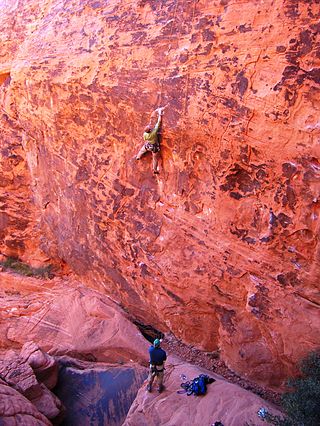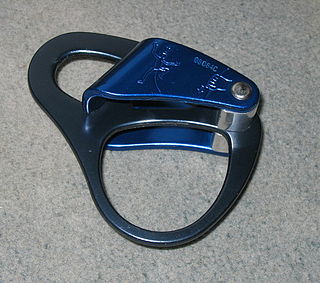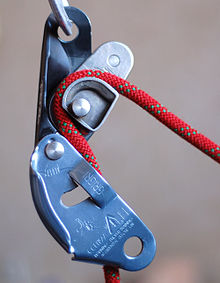
Glossary of climbing terms relates to rock climbing, mountaineering, and to ice climbing.

Rock-climbing equipment varies with the specific type of climbing that is undertaken. Bouldering needs the least equipment outside of climbing shoes, climbing chalk and optional crash pads. Sport climbing adds ropes, harnesses, belay devices, and quickdraws to clip into pre-drilled bolts. Traditional climbing adds the need to carry a "rack" of temporary passive and active protection devices. Multi-pitch climbing, and the related big wall climbing, adds devices to assist in ascending and descending fixed ropes. Finally, aid climbing uses unique equipment to give mechanical assistance to the climber in their upward movement.

Abseiling, also known as rappelling, is the controlled descent of a steep slope, such as a rock face, by moving down a rope. When abseiling, the person descending controls their own movement down a static or fixed rope, in contrast to lowering off, in which the rope attached to the person descending is paid out by their belayer.

Solo climbing, or soloing, is a style of climbing in which the climber climbs a route alone, without the assistance of a belayer or being part of a rope team. By its very nature, solo climbing presents a higher degree of risk to the climber, and in some cases, particularly where the climber is also not using any form of climbing protection, it is considered an extremely high-risk activity.
Self-locking devices are pieces of rock-climbing equipment intended to arrest the fall of solo climbers who climb without partners. This device is used for rope solo climbing, for "ground-up climbing", and for "top rope solo climbing". To date, several types of self-locking devices have evolved.

In climbing and mountaineering, belaying comprises techniques used to create friction within a climbing protection system, particularly on a climbing rope, so that a falling climber does not fall very far. A climbing partner typically applies tension at the other end of the rope whenever the climber is not moving, and removes the tension from the rope whenever the climber needs more rope to continue climbing. The belay is the place where the belayer is anchored, which is typically on the ground, or on ledge but may also be a hanging belay where the belayer themself is suspended from an anchor in the rock on a multi-pitch climb.

Top rope climbing is a form of rock climbing where the climber is securely attached to a climbing rope that runs through a fixed anchor at the top of the climbing route, and back down to the belayer at the base of the climb. A climber who falls will just hang from the rope at the point of the fall, and can then either resume their climb or have the belayer lower them down in a controlled manner to the base of the climb. Climbers on indoor climbing walls can use mechanical auto belay devices to top rope alone.

The Munter hitch, also known as the Italian hitch, mezzo barcaiolo or the crossing hitch, is a simple adjustable knot, commonly used by climbers, cavers, and rescuers to control friction in a life-lining or belay system. To climbers, this hitch is also known as HMS, the abbreviation for the German term Halbmastwurfsicherung, meaning half clove hitch belay. This technique can be used with a special "pear-shaped" HMS locking carabiner, or any locking carabiner wide enough to take two turns of the rope.

An ascender is a device used for directly ascending, or for facilitating protection, with a fixed rope when climbing on steep mountain terrain. A form introduced in the 1950s became so popular it began the term "Jumar" for the device, and the verb "to jumar" to describe its use in ascending.

Petzl is a French manufacturer of climbing gear, caving gear, work-at-height equipment, and headlamps based in Crolles, France. The company was created by the cave explorer Fernand Petzl in the mid-1970s. Their three specialties are:

A Prusik is a friction hitch or knot used to attach a loop of cord around a rope, applied in climbing, canyoneering, mountaineering, caving, rope rescue, ziplining, and by arborists. The term Prusik is a name for both the loops of cord used to tie the hitch and the hitch itself, and the verb is "to prusik" or "prusiking". More casually, the term is used for any friction hitch or device that can grab a rope. Due to the pronunciation, the word is often misspelled Prussik, Prussick, or Prussic.
In rock climbing, an anchor can be any device or method for attaching a climber, rope, or load to a climbing surface—typically rock, ice, steep dirt, or a building—either permanently or temporarily. The intention of an anchor is case-specific but is usually for fall protection, primarily fall arrest and fall restraint. Climbing anchors are also used for hoisting, holding static loads, or redirecting a rope.

Single-rope technique (SRT) is a set of methods used to descend and ascend on the same single rope. Single-rope technique is used in caving, potholing, rock climbing, canyoning, roped access for building maintenance and by arborists for tree climbing, although to avoid confusion in the tree climbing community, many have taken to calling it "stationary" rope technique.

Rope-solo climbing or rope-soloing is a form of solo climbing, but unlike with free solo climbing, which is also performed alone and with no climbing protection whatsoever, the rope-solo climber uses a mechanical self-belay device and rope system, which enables them to use the standard climbing protection to protect themselves in the event of a fall.

A Reverso is a belay device developed and patented by Petzl, used for example in rock-climbing and other activities which involves rope-work. Another version of this device is the Reversino, intended for use with thinner ropes.

A dynamic rope is a specially constructed, somewhat elastic rope used primarily in rock climbing, ice climbing, and mountaineering. This elasticity, or stretch, is the property that makes the rope dynamic—in contrast to a static rope that has only slight elongation under load. Greater elasticity allows a dynamic rope to more slowly absorb the energy of a sudden load, such from arresting a climber's fall, by reducing the peak force on the rope and thus the probability of the rope's catastrophic failure. A kernmantle rope is the most common type of dynamic rope now used. Since 1945, nylon has, because of its superior durability and strength, replaced all natural materials in climbing rope.

A belay device is a mechanical piece of climbing equipment used to control a rope during belaying. It is designed to improve belay safety for the climber by allowing the belayer to manage their duties with minimal physical effort. With the right belay device, a small, weak climber can easily arrest the fall of a much heavier partner. Belay devices act as a friction brake, so that when a climber falls with any slack in the rope, the fall is brought to a stop.

Simul-climbing is a climbing technique where a pair of climbers who are attached by a rope simultaneously ascend a multi-pitch climbing route. It contrasts with lead climbing where the leader ascends a given pitch on the route while the second climber remains in a fixed position to belay the leader in case they fall. Simul-climbing is not free solo climbing, as the lead simul-climber will clip the rope into points of climbing protection as they ascend. Simul-climbing is different from a rope team and short-roping, which are used for flatter terrain that doesn't typically need protection points.

A Petzl Stop is a descender used primarily in caving and formerly used for industrial rope access made by the French company Petzl.

The Revo is a semi-automatic belay device manufactured under the brand Wild Country by manufacturer Oberalp, for sports climbing with single ropes. It appeared on the market in autumn 2018.






















